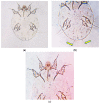Amelioration of Sarcoptic Mange-Induced Oxidative Stress and Growth Performance in Ivermectin-Treated Growing Rabbits Using Turmeric Extract Supplementation
- PMID: 34680003
- PMCID: PMC8532694
- DOI: 10.3390/ani11102984
Amelioration of Sarcoptic Mange-Induced Oxidative Stress and Growth Performance in Ivermectin-Treated Growing Rabbits Using Turmeric Extract Supplementation
Abstract
In this experiment, the protective effect of turmeric extract (TE) on side effects of Ivermectin-treated rabbits, while improving their performance, blood characteristics, and antioxidant status, was investigated. Sixty-three clinically Sarcoptes-infested rabbits aged 60 days were randomly allocated into three groups, with 21 rabbits in each group, to receive either no TE or TE supplementation (1 or 2 mg/kg diet) for 30 days after being subcutaneously injected with Ivermectin (IVM) 1% w/v at a dose of 0.2 mg/kg body weight twice a week. Another 21 healthy rabbits were used as the control. Treatment with IVM + 1 and 2 mg TE improved body weight (BW), body weight gain (BWG), feed intake (FI), and feed conversion ratio (FCR) in infested rabbits (p < 0.05). The IVM alone treatment had the highest mortality rate compared with the other treatments. Rabbits treated with IVM + 1 and 2 mg TE demonstrated progressive recovery manifested by improved nutrient digestibility and nitrogen balance. On day 7, the serum total protein, albumin, and albumin/globulin (A/G) ratio were significantly lower in the treated groups compared with the control group; also, the lowest values were observed in rabbits treated only with Ivermectin, followed by IVM + 1 and 2 mg TE. Treated rabbits had higher thiobarbituric acid reactive substance (TBAR) levels, but lower total antioxidant capacity (TAC), superoxidase dismutase (SOD), and glutathion peroxidase (GSH-Px) levels compared with the control group. On day 30 post-treatment, the rabbits in the IVM + 1 and 2 mg TE treatment groups showed progressive recovery manifested by improved biochemichal parameters, as well as a remarkable improvements in the oxidant/antioxidant balance towards normalcy (p < 0.05), and became comparable to that of the control compared with IVM alone treatment. In conclusion, turmeric extract improved rabbits' performance toward normalcy, and has remarkable antioxidant properties and can be used in conjunction with a miticide to treat sarcoptic mange in rabbits.
Keywords: antioxidant status; ivermectin; performance; rabbit; sarcoptic mange; turmeric extract.
Conflict of interest statement
The authors declare no conflict of interest.
Figures
References
-
- Darzi M.M., Mir M.S., Shahardar R.A., Pandit B.A. Clinicopathological, histochemical and therapeutic studies on concurrent sarcoptic and notoedric acariosis in rabbits (Oryctolagus cuniculus) Vet. Arhiv. 2007;77:167–175.
-
- Bornstein S., Mörner T., Samuel W.M. Sarcoptes scabiei and sarcopticmange. In: Samuel W.M., Pybus M.J., Kocan A.A., editors. Parasitic Diseases of Wild Mammals. 2nd ed. Iowa State University Press; Ames, IA, USA: 2001. pp. 107–119.
LinkOut - more resources
Full Text Sources


